Gerald Almy | Originally published in GameKeepers: Farming for Wildlife Magazine. To subscribe, click here.
The deer’s massive main beam and long, sweeping tines seemed to glow with their own inner light on that gray, drizzly day. It was one of the most impressive racks I had seen in many years of hunting. My heart skipped a beat and pumped double-time at the sight.
There was something different, though, about this encounter from other deer hunting experiences I’ve had. It happened in April. And instead of a brace of antlers atop a buck’s head, it was just half of a rack…a single five-point antler resting softly on a bed of oak leaves. It was left by a male deer that no longer needed it and looked like he had set it there for safe keeping.
While the buck didn’t need it, for me finding that shed antler was exhilarating. It let me know this deer was in fact still alive, traveling these woods and slowly beginning the process of creating yet another set of antlers. And this year they would likely be even bigger than the impressive rack he carried during the last season.
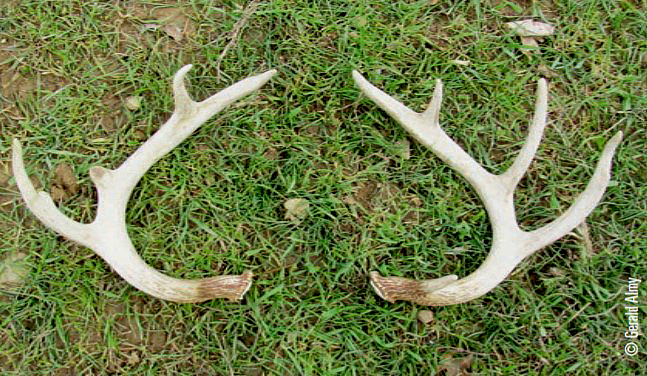
If you don’t think hunting for shed antlers can be exciting, you’ve probably never given it a serious try.I started about 15 years ago and every year it seems I become a more avid shed hunter. I can honestly say I enjoy it almost as much as hunting with a gun or bow during fall seasons.
I’m not the only one. Shed hunting has become so popular that guided week-long “shed hunts” in prime areas with food and lodging included can cost $2,500 or more. But don’t let that scare you. You can also hunt sheds by yourself in your own hunting area or on public land - for free.
The reasons why searching for shed antlers is so popular are easy to see. It’s the perfect way to extend your interest in deer and your time spent “hunting” for them. It’s a great way to get exercise and keep fit after the season is finished. Shed hunting can also be a great family participation sport, not to mention that big sheds can bring in big buck$...pun intended.
However, one of the major attractions of this activity for many of us is the pure challenge of it. The feeling you get when you spot a bone-colored antler tip protruding from a blanket of snow or peeking out from a bed of fallen leaves brings a special joy that’s hard to describe. To me the experience is a lot like spotting a good buck while still hunting, but one you just plan to watch and enjoy before moving on.
Shed hunting is more than just fun. It’s also valuable for helping formulate hunting strategies for the coming season and making management decisions such as which bucks to harvest and which ones need another year or two to mature.
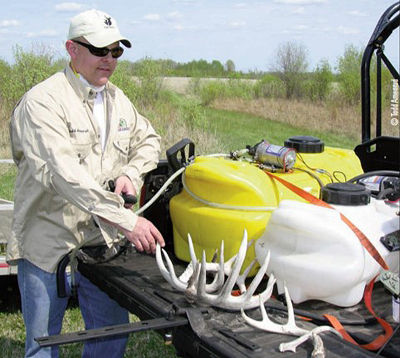
what was Winter Bulbs & Sugar Beets. The deer were thick
in the plot during March, cleaning out the turnips left over
from the fall before.
Finding sheds lets you identify deer that are still out there to challenge you next fall. Along with trail-cameras, finding sheds also helps in estimating the buck population and age structure of those animals. You can also take notes on genetic traits such as long or short tines, main beam shape, and those fascinating odd points that make some animals non-typical.
The most important practical information I get from sheds in regards to a specific animal, is a good estimate of age. Measuring the main beam is helpful, but most important of all is mass. By seeing the exact mass of a rack, in your hands and under the tape measure, you can usually tell pretty accurately how old a buck is, based on circumference measurements and age of past deer you’ve harvested in that area.
You can also test and improve your field judging skills because of shed hunting by estimating mass measurements, tine length and main beams for bucks you capture images of on trail cameras or see through optics while hunting. Write them down. Then, compare this with the actual measurements you get when you find the shed and record the real thing. This should tell you how good you are and where you tend to over or underestimate the antler’s measurements.
I consider searching for sheds to be “hunting” - just a different form of it. “Catch and release” has become popular among fishermen. Searching for sheds is “catch and release” deer hunting. It’s a challenge to understand the life and movements of a specific buck. Find the rack, or half of it, from an animal in your hunting area and you feel in one sense like you’ve “bagged” him, or at least one of the most intriguing parts of him—a part he no longer has use for.
Grasp the rack in your hands, run your fingers over it and feel the rough and smooth textures. Count the tines, study the abnormal points and stickers, all the while knowing the buck that left the antler is more than likely still out there, alive and elusive, challenging you to hunt for him next year. His rack will likely be more impressive next year, with greater mass, longer beams, maybe extra points, but usually in the same basic form.
If these weren’t enough attractions, hunting shed antlers can make you a better hunter by showing you what areas mature animals do and don’t use on the land you hunt. No other time is as valuable for ferreting out the travel patterns of mature bucks as the period from late winter through spring. Because of this, I often combine post-season scouting with shed hunting, doubling the benefits of the time spent in the woods. Note where the shed was and try to pinpoint whether it was a travel corridor, a bedding area, a spot only used for wintering or a spot providing food for the period. Mark that on a map or in a journal to reference next year when searching for a late season buck or trying to pinpoint bedding areas and travel routes. If you really want to multitask, carry a light rifle on your back for predators, listen for gobblers and watch for turkey sign as you shed hunt!
When to Begin?
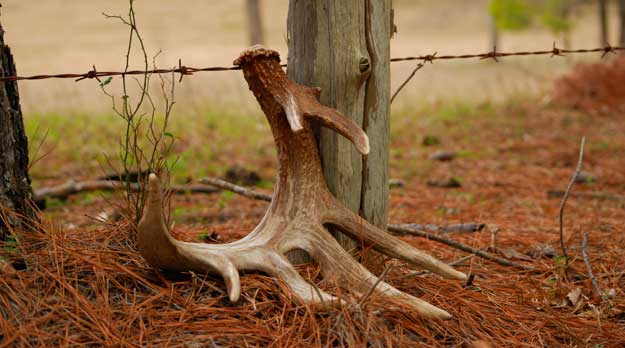
On rare occasions I’ve seen bucks where I live in Virginia drop antlers as early as late December. This is very unusual, though. Most deer hold their racks through much or all of January. February and March are when most bucks “go bald.” But I’ve watched a few stubbornly cling to one or both sides of their racks until April.
So you can start hunting sheds as early as January, but the longer you wait, the more likely most or all bucks will have dropped their racks. If shed hunting is popular in your area, on the other hand, you may want to make a number of forays, starting early to find the first sheds that drop and then re-covering that ground again later. That way you can be “one up” on others finding the antlers before you.
If you wait too long to start searching, weeds and grasses will start to grow and make the antlers more difficult to spot. Mice and chipmunks may also gnaw on them to obtain calcium and phosphorous. It’s disheartening to find a beautiful shed with “bite marks” in it!
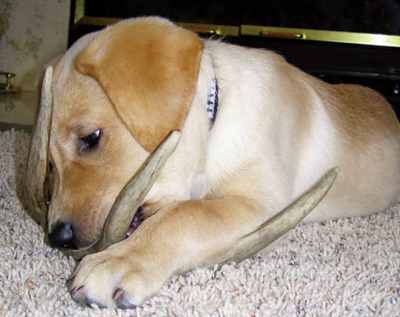
each year. If you do, make sure to start them out early
getting used to sheds.
While deer may shed both of their antlers within minutes, even seconds of one another in the same spot, this is the exception rather than the rule. Once I found a two-year-old buck’s eight point rack neatly laid out at the edge of an oval bed in a grove of cedars. That deer must have gone to sleep and woke up “antlerless.” But that’s one of just a small number of sets I’ve found so close together. Sometimes you’ll discover just one antler of an animal and never retrieve the other side. In other cases, you may find it, but far away from where the other half of the rack was.
I’ve located the two sides of a buck’s rack a mile apart from each other. (I knew it was the same buck’s distinctive antlers from watching and photographing it during the summer). It’s possible to find a few shed antlers by just taking a random walk in the woods, but you'll need lots of luck to succeed that way. Instead, focus your efforts more. Start searching in areas where you’ve seen the quarry late in the hunting season. Prime locations are spots with native foods or leftover agricultural crops located near heavy cover where the animals can hole up during the day and sneak out late in the evening or at night for a bite to eat.
Thick stands of conifers, swamps, south and southwest-facing slopes and benches, coulees, ravines and stream bottoms that offer some protection from cold winter winds are all good bets for shed hunting. Check out stands of rhododendron, plum, olive, laurel, and pine as well as thickets with greenbriers, honeysuckle and heavy sapling growth. Some bucks drop their antlers along heavily-used trails, so these are definitely worth following. Also check at fence crossings and narrow gullies or creeks where an animal might jump across and jar the antler loose as it lands on the other side.
Freshly logged areas are good spots to try because animals will gravitate there in the winter to feed on the tree tops left from the cutting. Burns are great places to hunt for sheds because the antlers stand out clearly against the black background with the weeds and grasses removed.
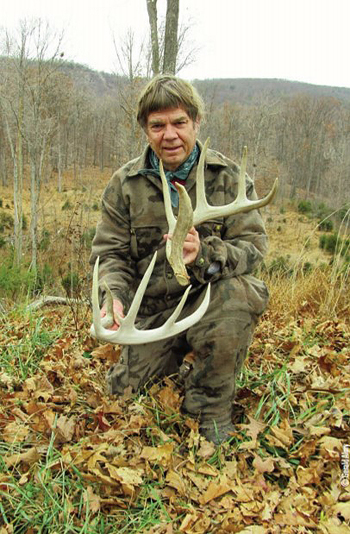
the mid 70s, suggesting a buck in the 160s.
Bucks often seem to drop their antlers at night, so you might find them in fairly open fields near concentrated food sources or food plots…but those are the easy ones. Figure on doing lots of walking and careful scanning through thick weeds, brush and leaf litter to locate most of the bits of headbone you find.
Try to use a systematic approach for the best results. Work in a straight line across the area you want to investigate and then move just above the area you covered and work back along a fresh strip of ground.
Some of the best shed hunting takes place right after a rain or even during a light drizzle. The antlers seem to shine with an inner glow when the rain moistens them. Cloudy days are also good. A harsh, glaring sunlight makes it harder to detect the antlers, but not impossible.
Always bring binoculars when shed hunting. If you see something that looks like a deer antler far away, you can often cut down excess walking by examining it through optics.
Don’t hesitate to recheck prime areas a second time, especially a few days later. Often I’ve thought I covered a location well, but came back through it a few days or weeks later in a different light or from a slightly different angle and found several more antlers this way.
If you like to make your outdoor pursuits a social event, gather a few friends and put on a “drive” through the area, with each hunter walking 15-30 yards apart as you scour the landscape. Most youngsters love to hunt for sheds if given the opportunity, so bring your kids or a neighborhood youngster. Some hunters get pets involved, training their dogs to find antlers.
Even if you make it a fun, social event, don’t forget to keep the dual purpose of post-season scouting and shed hunting in mind as you search. By also being on the lookout for rub lines, scrapes, trails, transition corridors, and beds as you walk through the woods and fields, you’ll find key pieces of information that can make you a more knowledgeable and successful hunter this fall.
Keep Your Expectations Realistic
The number of antlers you find will vary widely according to the density and maturity of the deer herd. Areas with a good population of mid to older-age animals will clearly yield better results than those with a heavily-pressured young herd. Fewer bucks live to cast off their antlers in the latter situation and if most animals are only one or two years old, the smaller antlers are much harder to see.
Even in low-odds areas, though, diligent searching should turn up at least a few sheds. And when they are scarcer and harder to come by, each piece of cast-off bone you do find will mean that much more.































